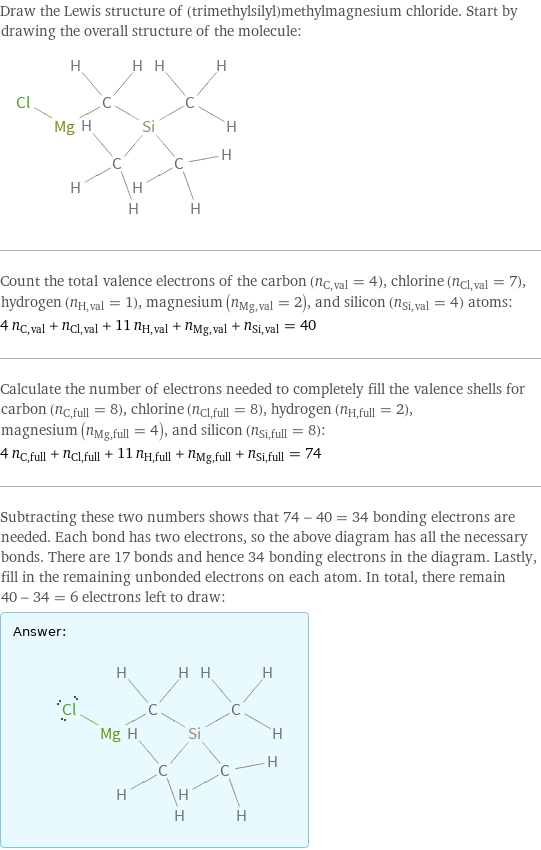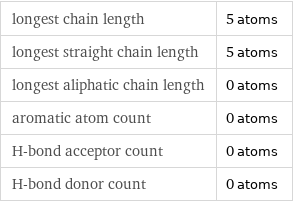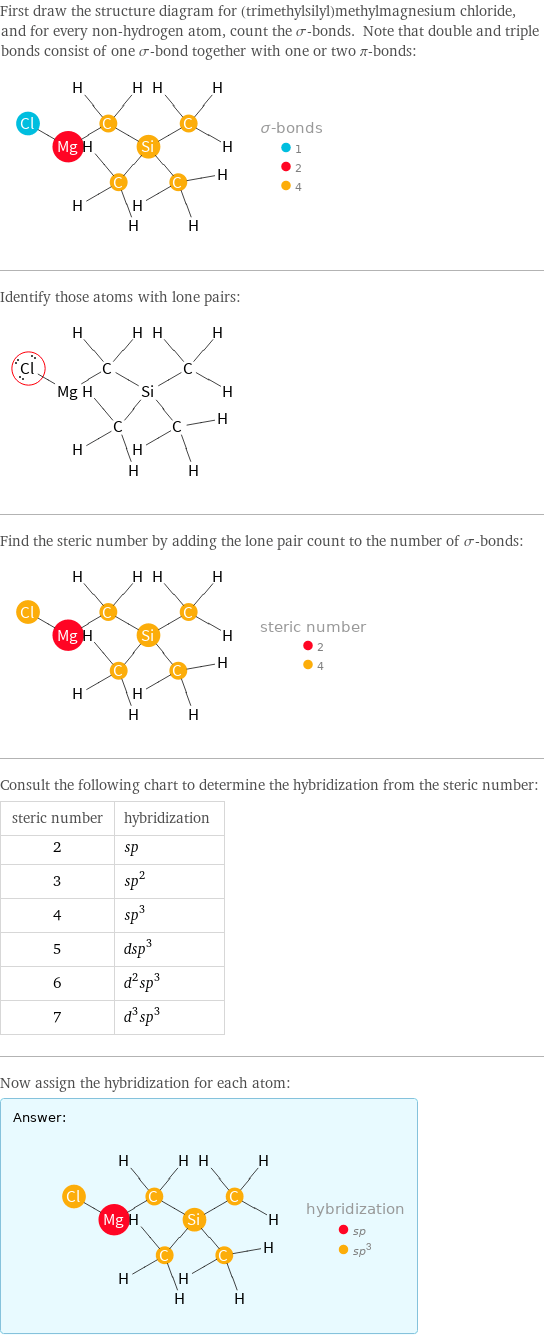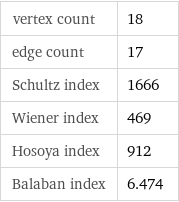Input interpretation

(trimethylsilyl)methylmagnesium chloride
Basic properties
(C)C[Mg]Cl InChI identifier | InChI=1/C4H11Si.ClH.Mg/c1-5(2, 3)4;;/h1H2, 2-4H3;1H;/q;;+1/p-1/fC4H11Si.Cl.Mg/h;1h;/q;-1;m InChI key | NAQATMJWCJCHOZ-UHFFFAOYSA-M](../image_source/866d68aa8c57be1a1886b93bb76a94d6.png)
molar mass | 147 g/mol formula | C_4H_11ClMgSi empirical formula | C_4Si_Mg_Cl_H_11 SMILES identifier | C[Si](C)(C)C[Mg]Cl InChI identifier | InChI=1/C4H11Si.ClH.Mg/c1-5(2, 3)4;;/h1H2, 2-4H3;1H;/q;;+1/p-1/fC4H11Si.Cl.Mg/h;1h;/q;-1;m InChI key | NAQATMJWCJCHOZ-UHFFFAOYSA-M
Lewis structure

Draw the Lewis structure of (trimethylsilyl)methylmagnesium chloride. Start by drawing the overall structure of the molecule: Count the total valence electrons of the carbon (n_C, val = 4), chlorine (n_Cl, val = 7), hydrogen (n_H, val = 1), magnesium (n_Mg, val = 2), and silicon (n_Si, val = 4) atoms: 4 n_C, val + n_Cl, val + 11 n_H, val + n_Mg, val + n_Si, val = 40 Calculate the number of electrons needed to completely fill the valence shells for carbon (n_C, full = 8), chlorine (n_Cl, full = 8), hydrogen (n_H, full = 2), magnesium (n_Mg, full = 4), and silicon (n_Si, full = 8): 4 n_C, full + n_Cl, full + 11 n_H, full + n_Mg, full + n_Si, full = 74 Subtracting these two numbers shows that 74 - 40 = 34 bonding electrons are needed. Each bond has two electrons, so the above diagram has all the necessary bonds. There are 17 bonds and hence 34 bonding electrons in the diagram. Lastly, fill in the remaining unbonded electrons on each atom. In total, there remain 40 - 34 = 6 electrons left to draw: Answer: | |
Quantitative molecular descriptors

longest chain length | 5 atoms longest straight chain length | 5 atoms longest aliphatic chain length | 0 atoms aromatic atom count | 0 atoms H-bond acceptor count | 0 atoms H-bond donor count | 0 atoms
Elemental composition

Find the elemental composition for (trimethylsilyl)methylmagnesium chloride in terms of the atom and mass percents: atom percent = N_i/N_atoms × 100% mass percent = (N_im_i)/m × 100% Plan: • Write the chemical formula and gather atomic masses from the periodic table. • Determine values for N_i, m_i, N_atoms and m using these items. • Finally, compute the percents and check the results. Write the chemical formula: C_4H_11ClMgSi Use the chemical formula to count the number of atoms, N_i, for each element and find the total number of atoms, N_atoms, per molecule: | number of atoms C (carbon) | 4 Si (silicon) | 1 Mg (magnesium) | 1 Cl (chlorine) | 1 H (hydrogen) | 11 N_atoms = 4 + 1 + 1 + 1 + 11 = 18 Divide each N_i by N_atoms to calculate atom fractions. Then use the property that atom fractions must sum to one to check the work: | number of atoms | atom fraction C (carbon) | 4 | 4/18 Si (silicon) | 1 | 1/18 Mg (magnesium) | 1 | 1/18 Cl (chlorine) | 1 | 1/18 H (hydrogen) | 11 | 11/18 Check: 4/18 + 1/18 + 1/18 + 1/18 + 11/18 = 1 Compute atom percents using the atom fractions: | number of atoms | atom percent C (carbon) | 4 | 4/18 × 100% = 22.2% Si (silicon) | 1 | 1/18 × 100% = 5.56% Mg (magnesium) | 1 | 1/18 × 100% = 5.56% Cl (chlorine) | 1 | 1/18 × 100% = 5.56% H (hydrogen) | 11 | 11/18 × 100% = 61.1% Look up the atomic mass, m_i, in unified atomic mass units, u, for each element in the periodic table: | number of atoms | atom percent | atomic mass/u C (carbon) | 4 | 22.2% | 12.011 Si (silicon) | 1 | 5.56% | 28.085 Mg (magnesium) | 1 | 5.56% | 24.305 Cl (chlorine) | 1 | 5.56% | 35.45 H (hydrogen) | 11 | 61.1% | 1.008 Multiply N_i by m_i to compute the mass for each element. Then sum those values to compute the molecular mass, m: | number of atoms | atom percent | atomic mass/u | mass/u C (carbon) | 4 | 22.2% | 12.011 | 4 × 12.011 = 48.044 Si (silicon) | 1 | 5.56% | 28.085 | 1 × 28.085 = 28.085 Mg (magnesium) | 1 | 5.56% | 24.305 | 1 × 24.305 = 24.305 Cl (chlorine) | 1 | 5.56% | 35.45 | 1 × 35.45 = 35.45 H (hydrogen) | 11 | 61.1% | 1.008 | 11 × 1.008 = 11.088 m = 48.044 u + 28.085 u + 24.305 u + 35.45 u + 11.088 u = 146.972 u Divide the mass for each element by m to calculate mass fractions. Then use the property that mass fractions must sum to one to check the work: | number of atoms | atom percent | mass fraction C (carbon) | 4 | 22.2% | 48.044/146.972 Si (silicon) | 1 | 5.56% | 28.085/146.972 Mg (magnesium) | 1 | 5.56% | 24.305/146.972 Cl (chlorine) | 1 | 5.56% | 35.45/146.972 H (hydrogen) | 11 | 61.1% | 11.088/146.972 Check: 48.044/146.972 + 28.085/146.972 + 24.305/146.972 + 35.45/146.972 + 11.088/146.972 = 1 Compute mass percents using the mass fractions: Answer: | | | number of atoms | atom percent | mass percent C (carbon) | 4 | 22.2% | 48.044/146.972 × 100% = 32.69% Si (silicon) | 1 | 5.56% | 28.085/146.972 × 100% = 19.11% Mg (magnesium) | 1 | 5.56% | 24.305/146.972 × 100% = 16.54% Cl (chlorine) | 1 | 5.56% | 35.45/146.972 × 100% = 24.12% H (hydrogen) | 11 | 61.1% | 11.088/146.972 × 100% = 7.544%
Elemental oxidation states

The first step in finding the oxidation states (or oxidation numbers) in (trimethylsilyl)methylmagnesium chloride is to draw the structure diagram. Next set every oxidation number equal to the atom's formal charge: In (trimethylsilyl)methylmagnesium chloride hydrogen is not bonded to a metal with lower electronegativity, so it will have an oxidation state of +1. Any element bonded to hydrogen gains the bonding electrons, decreasing their oxidation state by 1 for every bond: With hydrogen out of the way, look at the remaining bonds. There are 1 carbon-magnesium bond, 4 carbon-silicon bonds, and 1 carbonl-magnesium bond. For each of these bonds, assign the bonding electrons to the most electronegative element. First examine the carbon-magnesium bond: element | electronegativity (Pauling scale) | C | 2.55 | Mg | 1.31 | | | Since carbon is more electronegative than magnesium, the electrons in this bond will go to carbon. Decrease the oxidation number for carbon (by 1 for single bonds, 2 for double bonds, and 3 for triple bonds), and increase the oxidation number for magnesium accordingly: Next look at the carbon-silicon bonds: element | electronegativity (Pauling scale) | C | 2.55 | Si | 1.90 | | | Since carbon is more electronegative than silicon, the electrons in these bonds will go to carbon: Next look at the carbonl-magnesium bond: element | electronegativity (Pauling scale) | Cl | 3.16 | Mg | 1.31 | | | Since chlorine is more electronegative than magnesium, the electrons in this bond will go to chlorine: Now summarize the results: Answer: | | oxidation state | element | count -4 | C (carbon) | 4 -1 | Cl (chlorine) | 1 +1 | H (hydrogen) | 11 +2 | Mg (magnesium) | 1 +4 | Si (silicon) | 1
Orbital hybridization

First draw the structure diagram for (trimethylsilyl)methylmagnesium chloride, and for every non-hydrogen atom, count the σ-bonds. Note that double and triple bonds consist of one σ-bond together with one or two π-bonds: Identify those atoms with lone pairs: Find the steric number by adding the lone pair count to the number of σ-bonds: Consult the following chart to determine the hybridization from the steric number: steric number | hybridization 2 | sp 3 | sp^2 4 | sp^3 5 | dsp^3 6 | d^2sp^3 7 | d^3sp^3 Now assign the hybridization for each atom: Answer: | |
Topological indices

vertex count | 18 edge count | 17 Schultz index | 1666 Wiener index | 469 Hosoya index | 912 Balaban index | 6.474